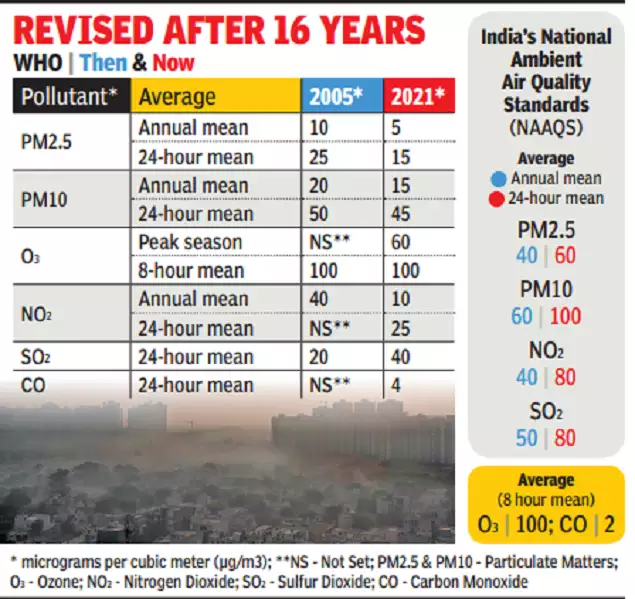Biodiversity & Environment
New WHO Global Air Quality Guidelines
- 23 Sep 2021
- 6 min read
Why in News
Recently, the World Health Organisation (WHO) has released new Global Air Quality Guidelines (AQGs). Under these guidelines, WHO has further lowered the recommended levels of pollutants that can be considered safe for human health.
- This is the first-ever update of WHO since 2005. The goal of the guideline is for all countries to achieve recommended air quality levels.
Key Points
- New Guidelines:
- The guidelines recommend new air quality levels to protect the health of populations, by reducing levels of key air pollutants, some of which also contribute to climate change.
- By striving to achieve these guideline levels, countries will be both protecting health as well as mitigating global climate change.
- WHO move sets the stage for eventual shifts in policy in the government towards evolving newer stricter standards.
- WHO’s new guidelines recommend air quality levels for 6 pollutants, where evidence has advanced the most on health effects from exposure.
- 6 classical pollutants include particulate matter (PM 2.5 and 10), ozone (O3), nitrogen dioxide (NO2) sulfur dioxide (SO2) and carbon monoxide (CO).
- New WHO Global AQGs vs India’s NAAQS:
- Effect of Air Pollution on Human Health:
- According to WHO, Air pollution is one of the biggest environmental threats to human health, alongside climate change.
- Every year, exposure to air pollution is estimated to cause 7 million premature deaths and result in the loss of millions more healthy years of life.
- In children, this could include reduced lung growth and function, respiratory infections and aggravated asthma.
- In adults, heart disease and stroke are the most common causes of premature death attributable to outdoor air pollution, and evidence is also emerging of other effects such as diabetes and neurodegenerative conditions.
- This puts the burden of disease attributable to air pollution on a par with other major global health risks such as unhealthy diet and tobacco smoking.
- Disparities in air pollution exposure are increasing worldwide, particularly as low- and middle-income countries are experiencing growing levels of air pollution because of large-scale urbanization and economic development that has largely relied on the burning of fossil fuels.
- Status of Pollution in India:
- India continues to remain one of the most polluted areas in the world, with pollutant levels several times higher than recommended levels.
- For example, a Greenpeace study found the average concentration of PM2.5 in New Delhi in 2020 to be nearly 17 times higher than the recommended levels.
- In Mumbai, pollution levels were eight times higher; in Kolkata, over nine times higher; and in Chennai, over five times higher.
- According to experts of Global Burden of Disease study, over 95% of India’s population already lived in areas where pollution levels were higher than WHO’s 2005 norms.
- India’s own national air quality standards are much more lenient, even compared to WHO’s 2005 norms.
- For example, the recommended PM2.5 concentration over a 24-hour period is 60 micrograms per cubic metre, compared to 25 micrograms advised by WHO’s 2005 guidelines.
- But even these lower standards are hardly met.
- India continues to remain one of the most polluted areas in the world, with pollutant levels several times higher than recommended levels.
- Impact of New Guidelines on India:
- The new air quality guidelines mean that nearly entire India would be considered a polluted zone for most of the year.
- However, by WHO’s own admission, more than 90% of the world’s population lived in areas which did not meet its 2005 pollution standards.
- The new WHO norms should push India to work harder to make its air cleaner and safer.
- Further, the feasibility of implementing the new guidelines is questionable, especially in challenging geo-climatic zones like south Asia, including India.
- Experts point out that this region has challenging meteorological and climatic conditions, with the added challenge of haze columns, heat island effects and very high base pollution.
- However, as the WHO’s guidelines are not binding, the move doesn’t immediately impact India as the National Ambient Air Quality Standards (NAAQS) don’t meet the WHO’s existing standards.
- The government has a dedicated National Clean Air Programme that aims for a 20% to 30% reduction in particulate matter concentrations by 2024 in 122 cities, keeping 2017 as the base year for the comparison of concentration.
- The new air quality guidelines mean that nearly entire India would be considered a polluted zone for most of the year.
Way Forward
- Given the condition of the Air Pollution in India, there is a need to strengthen health data and revise National ambient air quality standards accordingly.
- Further, the hard lockdown phases during the pandemic have demonstrated the dramatic reduction that is possible when local pollution and regional influences can be minimised.





